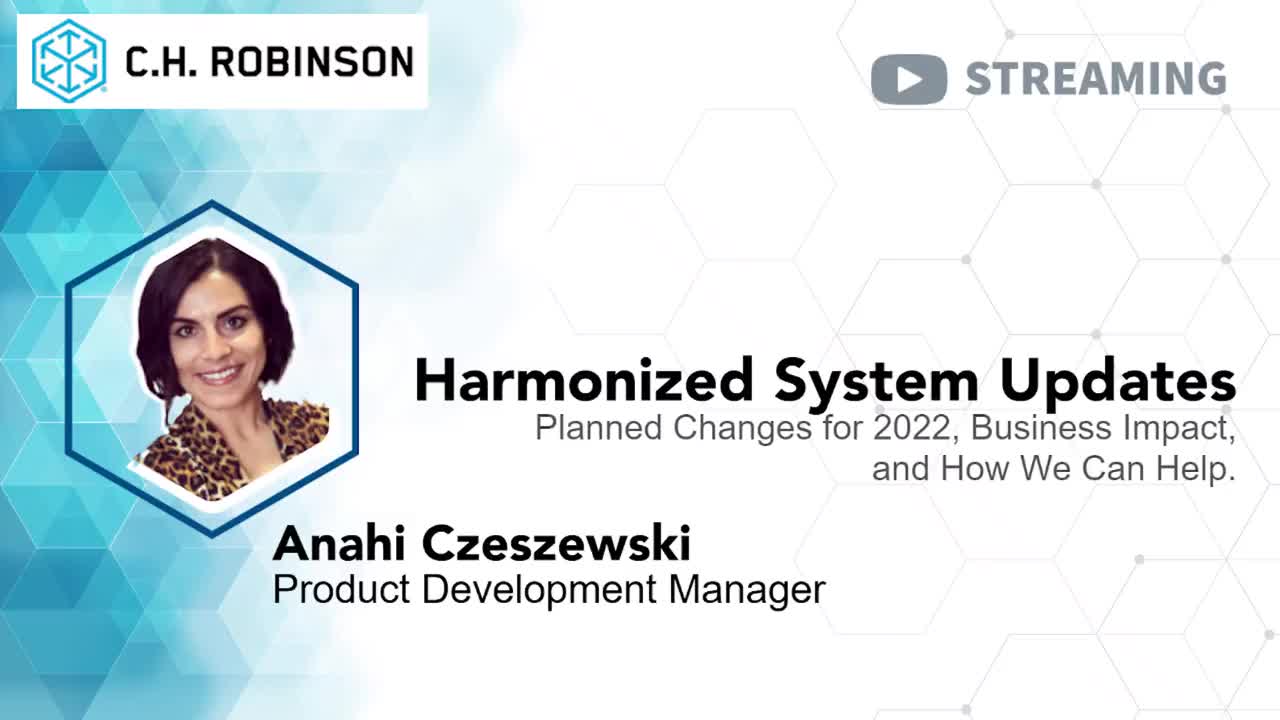Recent Trade & Tariff Perspectives
November 17, 2021 | Anahi Czeszewski Product Development Manager

Proactively Prepare for the Upcoming 2022 Harmonized System Updates
As year end rapidly approaches, it’s time to review your tariff classifications. This year is especially critical, as the World Customs Organization (WCO) has made more than 350 amendments to the Harmonized System, going into effect on January 1, 2022. Act now to avoid costly shipping delays and significant compliance issues in your supply chain.
Watch this week's Trade & Tariff perspective:

What is the Harmonized System?
Established in 1988, the Harmonized System (HS) was enacted to provide structure and uniformity for the classification of more than 5,000 globally traded commodity groups. The HS serves as a basis for customs tariffs for more than 200 countries and economies across the world, with the mutual agreement to use the same six-digit product classification codes.
What is changing in the HS nomenclature in 2022?
Every five years, the WCO undertakes a review of the existing HS and determines whether appropriate amendments should be created to remain current. The external factors considered are product advances in technology, new product stream development, environmental concerns, and changes in global trade. The amendments in this seventh iteration of the HS comprise 351 sets of amendments.
Technological advancements
There is no dispute—technology is ever evolving. To ensure the HS nomenclature 2022 appropriately reflects the significant advancements that have occurred in the past five years, amendments were created. Products affected as a result of such changes include:
- Novel tobacco and nicotine-based products (i.e., vapes)
- Drones
- Smartphone devices
- Flat-panel display modules
- Glass fibers and articles thereof
- Metal-forming machinery
Health and safety at the forefront
Recognizing that infectious diseases and outbreaks are a constant global threat, new provisions have also been added for items used in diagnostic efforts and medical research, including:
- Diagnostic kits
- Placebos and clinical trial kits for medical research
- Cell cultures and cell therapy
Protection of society
Maintaining a committed focus on the fight against terrorism, numerous subheadings have been created for dual-use goods that can be used in unauthorized ways, such as:
- Radioactive materials
- Biological safety cabinets
- Items used to construct explosive devices
How can this impact my company?
The classification of merchandise impacts importers and exporters across the globe, as classification has a bearing on not only the most favored nation (MFN) duty rate, but other significant implications, including:
- Punitive tariffs could potentially be added to your bottom line or possibly be removed. Consider Section 301 China tariffs and Section 232 steel and aluminum tariffs.
- Modification to the HS can potentially change your eligibility for participation in preferential trade agreements, such as the United States – Mexico – Canada Agreement. Review the implications now to understand the impact on your future landed cost.
- Products may need to meet new (or additional) partner government agency requirements.
- Amendments could result in new flags for antidumping and countervailing duty cases, which were previously unflagged.
Proactively navigate through the HS 2022 amendments
Companies participating in cross-border trade must be proactive and take action to understand their global impact from the upcoming HS amendments. Consider implementing these steps today:
- Familiarize yourself with the HS nomenclature 2022, as published by the WCO.
- Study the correlation tables to analyze the changes from HS 2017 to HS 2022. The two tables can be used as a guide to compare the various amendments. Not all modifications will result in a new tariff heading. For example, some amendments only include additional clarification in descriptions, based on the evolution of certain products.
- Use the HS tracker, created by the WCO, which allows you to visually see changes throughout the previous HS iterations, as well as gain insight into the rationale behind such changes. (See HS at a glance example in Exhibit A, below.)
- If specifically importing into the United States, read the United States International Trade Commission’s recommendations to the President and guidance on the amendments for the Harmonized Tariff Schedule of the United States (HTSUS).
- Similarly, if shipping to other countries, stay informed on each country’s adoption of the HS 2022 amendments, such as Canada’s Customs Tariff and the EU’s Combined Nomenclature.
- Ensure that as a reflection of the HS 2022, your parts database is updated, as necessary. Consider each country you ship to, as each country will have its own specific adoption to the HS 2022 amendments.
- Communicate your updated parts database to your customs brokers as soon as possible to avoid clearance delays.
- Consider proposing a change if you do not believe your products are correctly defined in the HS 2022. (The HS Committee meets every six months to review proposed changes. It is not too early to begin your preparation efforts now.)
Exhibit A: HS at a glance (HS 2022 updates to heading 8462)
Source: HS Tracker, published by the WTO
Next steps
Need help classifying your products? Our dedicated classification team can help you navigate through the upcoming tariff changes and assist with the classification of your products once country-specific adoptions are made available. Connect with one of our trade policy experts to learn more.
Resources
Review recent perspectives
- March 2 | Customs and Trade Policy Developments We’re Following This Month
- February 16 | Transporting goods inside Mexico. Are you complying with Complemento Carta Porte?
- February 2 | Canada to U.S. Shipments: Your Guide to Reducing Import Costs
- January 19 | Importing into the United States from Canada? Here’s What You Need to Know
